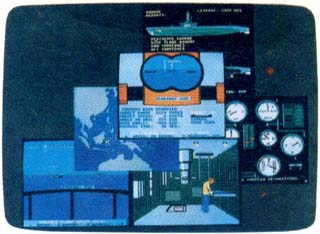Reviews
Silent Service
Neil Randall
Requirements: Commodore 64 or 128 (in 64 mode); Apple II-series computer with at least 64K RAM; Atari 400/800, XL, or XE with at least 48K RAM; IBM PC with color/graphics adapter; or an IBM PCjr. A disk drive is also required, and a joystick is recommended. The Commodore version was reviewed.
Silent Service, from Microprose Software, is one of a new type of computer war game. A cross between arcade action games and traditional strategy war games, these new games put you on the battlefield in command of a plane, tank, or submarine. Microprose's F-15 Strike Eagle placed you in a modern jet fighter. In Silent Service, you're the captain of a U.S. submarine in the Pacific during World War II. Your mission is to sink Japanese cargo, troop, and oil shipping. The game includes several scenarios based on actual engagements.
Silent Service employs several graphics screens to relay the information needed to command the sub. The Patrol Navigation Map shows a 150,000 square-mile area of the Pacific Ocean from Midway Island to China (east to west), and Australia to the U.S.S.R. (south to north). This is the strategic map on which you move your sub to find Japanese shipping lanes. Once you've found a convoy, the tactical map kicks in.
The tactical map is actually a series of three differently scaled maps. The Patrol Area Map is described above. You can zoom to the Navigation Map, which shows an area of 2,400 square miles around your sub, and zooming further yields the Attack Plot, a 40-square-mile area. The detail of land masses and enemy ships changes with the zoom. The Attack Plot displays the wake of each ship, to show which direction it is going. You use the Patrol Area Map to find the enemy convoy, the Navigation Map to close in on it, and the Attack Plot to position your sub for attack.
Superb Graphics
Once you've located your prey, you shift to a view of the conning tower, the captain's station. Using the joystick (the game is joystick- or keyboard-controlled), you either use the periscope or move the captain to one of the other stations: instruments and gauges, maps and charts, damage reports, quartermaster's log, or the bridge. Like the map screens, each battle station screen is graphically superb and very detailed.
If the sub is surfaced, you can climb to the bridge. From here you can look around to spot the enemy ships, using your naked eyes or binoculars. The view includes the Japanese ships (several varieties, each graphically different) and the land on the horizon. The landforms correspond exactly to where you are in the Pacific; if you patrol to the coast of New Guinea, you will see the coast of New Guinea. Given the amount of territory covered in the game, the mapping system is obviously very sophisticated.
The binoculars and periscope screens include all the details necessary for firing at the ships: target type, target range and speed, and such data as angle-on-bow. You may fire the deck guns or torpedoes, but only torpedoes are consistently effective.
These screens are the heart of the action, but to keep the sub running you must pay strict attention to your vessel's instruments and gauges. They display information about the battery, the depth of the sub and of the ocean floor beneath you, fuel levels, the status of hull openings, and so on. For instance, the battery allows restricted underwater maneuvering, depending on your speed, and then must be recharged on the surface.

This assortment of screens from Silent Service
shows the diversity of the program's graphics.
Attention To Detail
Other facets of the game are equally realistic. If your sub hits the ocean bottom, you hear a scraping sound and the hull may be damaged. You can cruise at four speeds or cut the engines for silent running. More esoterically, once per mission you can get rid of your emergency tanks to stop a fatal dive, or release debris to the surface to fool the Japanese destroyers into thinking you've been sunk. Sound effects range from sonar pings-telling you that destroyers are closing in-to the ominous explosions of nearby depth charges. The sub's hull even creaks if you dive deeper than it was tested for, and you hear a grinding metallic sound if you're rammed by an enemy ship. Silent Service's detail is astonishing.
But the most impressive part of the detail is that it does not impede play. Detail in the more traditional type of war game frequently hinders understanding and lengthens the game considerably, but Silent Service plays quite easily after only a half-hour or so of practice. Once you learn how to steer the sub and fire torpedoes at a target, you can try a mission. You can learn the rest, such as diving and running silent at the approach of a Japanese destroyer, as the situation demands. At any time, you can pause the game to allow you time to think.
Like F-15 Strike Eagle, Silent Service is both intriguing and addicting. Also like F-15, it is highly educational, but there is nothing tedious about the lessons. The excellent manual describes the submarine war in the Pacific, the background to the scenarios, and the tactics used by sub captains. By playing the game, you'll quickly find that these captains knew what they were doing. Silent Service is a superior product.
Silent Service
MicroProse Software Inc.
120 Lakefront Drive
Hunt Valley, MD 21030
$34.95-$39.95 (depending on version)